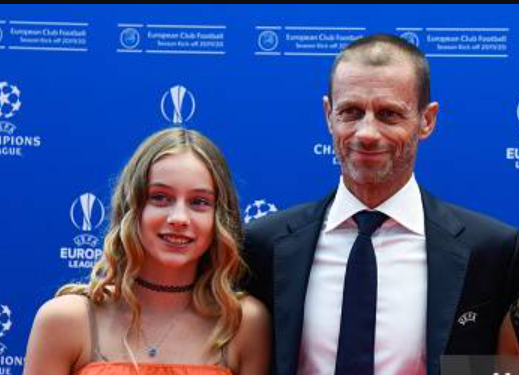The daughter of UEFA President Aleksander Čeferin, Petra Čeferin, has distinguished herself as a renowned academic and architect by forging her own career path away from the glitz of football politics. Instead of being overwhelmed by her father’s prominent position, Petra has remarkably molded a life grounded in academic rigor. She teaches at the University of Ljubljana’s Faculty of Architecture, where she has an impact on students and the direction of urban design.

Petra’s story is remarkably obvious in its independence, even if her father, Aleksander, has been unanimously re-elected as UEFA President and is leading European football with astute decisions. She places a higher value on design integrity than her father does on football integrity, which is an especially creative contrast. Petra’s achievements have garnered more and more recognition in academic circles in recent days, while her father has been in the news for reforms involving Carlo Ancelotti, José Mourinho, and Zinedine Zidane.
UEFA President Daughter – Petra Čeferin
| Name | Petra Čeferin |
|---|---|
| Profession | Architect and Professor |
| Institution | Faculty of Architecture, University of Ljubljana |
| Father | Aleksander Čeferin, UEFA President |
| Nationality | Slovenian |
| Siblings | Two sisters |
| Link | UEFA Official Website |
Petra’s perspective was greatly influenced by her upbringing in the Čeferin household, where discipline and adventure went hand in hand. Petra’s perseverance in navigating intellectual deserts in design is reflected in Aleksander’s history as a lawyer, Shotokan Karate black belt, and explorer who has traversed the Sahara Desert numerous times. The metaphor’s effectiveness in illustrating how a father and daughter can flourish in disparate environments while maintaining the same level of endurance is remarkable.
Petra concentrates on more subdued but no less significant issues—sustainable spaces, academic research, and student mentorship—while UEFA handles contentious discussions about officiating standards, match schedules, and player welfare. This duality—one sibling of power and notoriety, the other of scholarship and subtle influence—is quite effective in explaining the dynamics of the larger Čeferin family.
The profundity of the family’s culture is likewise remarkable. Aleksander speaks English, Slovene, Croatian, and Italian fluently, and his girls were raised in a bilingual home. Petra’s architectural lens and this exposure are remarkably comparable in that they are both varied, multi-layered, and enriched with influences. She integrates that variety into her instruction to make sure her students understand architecture as cultural conversations as much as buildings.
Petra has chosen this path, which is very advantageous for Slovenia’s image. Petra’s academic contributions elevate Slovenia’s standing in intellectual and cultural circles, while her father’s leadership solidifies Slovenia’s place in football governance. Collectively, they represent how, when talent is developed in a variety of fields, small nations may exert disproportionately enormous influence.
Petra has greatly diminished the perception that children of public persons depend on parental status by working with her classmates and mentoring pupils. Like Amal Clooney, who gained international recognition for her global legal influence rather than George Clooney, Petra stands alone and rewrites her story according to her own standards. She serves as a reassuring reminder that identity is created via free will rather than inherited.
Petra’s work is extremely successful in the context of international discussions around sustainability and urban planning. Scholars like her are leading the charge to find solutions for the huge challenges that European cities face, including congestion, climate change, and cultural protection. She demonstrates how societal impact may be enormous even in more subdued professions. She is influencing the areas where communities live, learn, and prosper, while her father may be influencing the football regulations.
Petra talks about preserving architectural qualities in her lectures, whereas Alexander talks about preserving football in UEFA congresses. The symmetry is very remarkable. They all uphold the same values of accountability and stewardship in their respective fields, demonstrating that influence may manifest itself in a variety of ways, some overt and others very covert.
Petra has contributed to global architectural discussions and increased her influence outside of Slovenia through published works and strategic alliances. While Petra’s achievements are linked to the constructed surroundings that subtly yet significantly influence human behavior, Alexander’s name is associated with billion-dollar competitions. This family’s dual commitment exemplifies a remarkably resilient history that spans both academia and athletics.
While Petra’s time in academia has significantly enhanced the conversation surrounding modern design, Alexander’s career has been characterized by the upheavals of football during the previous 10 years, including the European Super League match. Though in such different contexts, each exhibits perseverance. This contrast supports the notion that public influence can occur in lecture halls, scholarly publications, and the schools where aspiring architects are formed, in addition to visible stages.
Petra Čeferin’s subtle disobedience of public expectations is what makes her so fascinating, not scandal or sensationalism. What might have been an inherited story has been changed by her into one of true independence. She reminds us that legacies are not always about making headlines; sometimes, they are about the buildings that endure for decades. Her dedication to design is incredibly evident.
